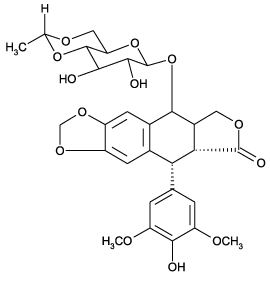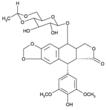Replaces Prod. #: ALX-270-209
Antitumor reagent. Topoisomerase II inhibitor. Induces apoptosis by FasL. Activates p53 resulting in upregulated expression of TRAIL-R2 (DR5) and Bak to overcome TRAIL resistance in Bax-deficient human colon carcinoma cancer cells.
Product Details
| Alternative Name: | 4-Desmethylepipodophyllotoxin 9-(4,6-O-ethylidene)-β-D-glucopyranoside, VP-16-213 |
| |
| Formula: | C29H32O13 |
| |
| MW: | 588.6 |
| |
| Source: | Semisynthetic derivative of podophyllotoxin. |
| |
| CAS: | 33419-42-0 |
| |
| MI: | 14: 3886 |
| |
| RTECS: | KC0190000 |
| |
| Purity: | ≥95% (HPLC) |
| |
| Appearance: | White to off-white powder. |
| |
| Solubility: | Soluble in DMSO, dimethyl formamide, ethyl ether or chloroform:methanol (1:1); slightly soluble in methanol or acetone; insoluble in water. |
| |
| Shipping: | Ambient Temperature |
| |
| Long Term Storage: | Ambient |
| |
| Use/Stability: | Store solutions in DMSO at 4°C. For long term storage prepare aliquots and store at -20°C. |
| |
| Handling: | Protect from light and moisture. |
| |
| Regulatory Status: | RUO - Research Use Only |
| |
Please mouse over
Product Literature References
Pregnancy-associated plasma protein-A (PAPP-A) is a key component of an interactive cellular mechanism promoting pulmonary fibrosis: L.K. Bale, et al.; J. Cell. Physiol.
237, 2220 (2022),
Abstract;
Use of transcriptomics in hazard identification and next generation risk assessment: A case study with clothianidin: H. Sprenger, et al.; Food Chem. Toxicol.
166, 113212 (2022),
Abstract;
Comparing effects of CDK inhibition and E2F1/2 ablation on neuronal cell death pathways in vitro and after traumatic brain injury: T.G. Aubrecht, et al.; Cell Death Dis.
9, 1121 (2018),
Abstract;
Full Text
Direct modification of the 5-HT3 receptor current by some anticancer drugs: Y. Nakamura, et al.; Eur. J. Pharmacol.
821, 21 (2017),
Abstract;
Pyroptosis and apoptosis pathways engage in bidirectional crosstalk in monocytes and macrophages: C.Y. Taabazuing, et al.; Cell Chem. Biol.
24, 507 (2017),
Abstract;
Full Text
Regulation of hepatic cholesteryl ester transfer protein expression and reverse cholesterol transport by inhibition of DNA topoisomerase II: M. Liu, et al.; J. Biol. Chem.
290, 14418 (2015),
Application(s): Cell Culture,
Abstract;
Full Text
The p53 binding protein PDCD5 is not rate-limiting in DNA damage induced cell death: F. J. Bock, et al.; Sci. Rep.
5, 11268 (2015),
Application(s): Cell Culture,
Abstract;
Full Text
The antiviral adaptor proteins Cardif and Trif are processed and inactivated by caspases: M. Rebsamen, et al.; Cell Death Differ.
15, 1804 (2008),
Abstract;
Etoposide, topoisomerase II and cancer: E.L. Baldwin & N. Osheroff; Curr. Med. Chem. Anticancer Agents
5, 363 (2005), Review,
Abstract;
Etoposide: discovery and medicinal chemistry: P. Meresse, et al.; Curr. Med. Chem.
11, 2443 (2004), Review,
Abstract;
Cell cycle phase specificity in the potentiation of etoposide-induced DNA damage and apoptosis by KN-62, an inhibitor of calcium-calmodulin- dependent enzymes: M. Aoyama, et al.; Biochem. Pharmacol.
61, 49 (2001),
Abstract;
Deacetylase activity associates with topoisomerase II and is necessary for etoposide-induced apoptosis: C.A. Johnson, et al.; J. Biol. Chem.
276, 4539 (2001),
Abstract;
Full Text
In vitro topo II-DNA complex accumulation and cytotoxicity of etoposide in leukaemic cells from patients with acute myelogenous and chronic lymphocytic leukaemia: Y. Wang, et al.; Leuk. Res.
25, 133 (2001),
Abstract;
A systematic review of the role of etoposide and cisplatin in the chemotherapy of small cell lung cancer with methodology assessment and meta-analysis: C. Mascaux, et al.; Lung Cancer
30, 23 (2000),
Abstract;
Distinct pathways for stimulation of cytochrome c release by etoposide: J.D. Robertson, et al.; J. Biol. Chem.
275, 32438 (2000),
Abstract;
Full Text
Early caspase activation in leukemic cells subject to etoposide-induced G2-M arrest: evidence of commitment to apoptosis rather than mitotic cell death: R.J. Sleiman & B.W. Stewart; Clin. Cancer Res.
6, 3756 (2000),
Abstract;
Full Text
Etoposide-induced apoptosis is not associated with the fas pathway in acute myeloblastic leukemia cells: T. Siitonen, et al.; Leuk. Res.
24, 281 (2000),
Abstract;
Ordering of ceramide formation, caspase activation, and Bax/Bcl-2 expression during etoposide-induced apoptosis in C6 glioma cells: M. Sawada, et al.; Cell Death Differ.
7, 761 (2000),
Abstract;
Etoposide sensitivity of human prostatic cancer cell lines PC-3, DU 145 and LNCaP: M. Salido, et al.; Histol. Histopathol.
14, 125 (1999),
Abstract;
Etoposide: four decades of development of a topoisomerase II inhibitor: K.R. Hande; Eur. J. Cancer
34, 1514 (1998),
Abstract;
Etoposide: twenty years later: J.D. Hainsworth & F.A. Greco; Ann. Oncol.
6, 325 (1995),
Abstract;
Review of current clinical experience with prolonged (oral) etoposide in cancer treatment: R.S. de Jong, et al.; Anticancer Res.
15, 2319 (1995),
Abstract;
Dexamethasone and etoposide induce apoptosis in rat thymocytes from different phases of the cell cycle: H.O. Fearnhead, et al.; Biochem. Pharmacol.
48, 1073 (1994),
Abstract;
The podophyllotoxin derivatives VP16-213 and VM26: B.F. Issell; Cancer Chemother. Pharmacol.
7, 73 (1982),
Abstract;












